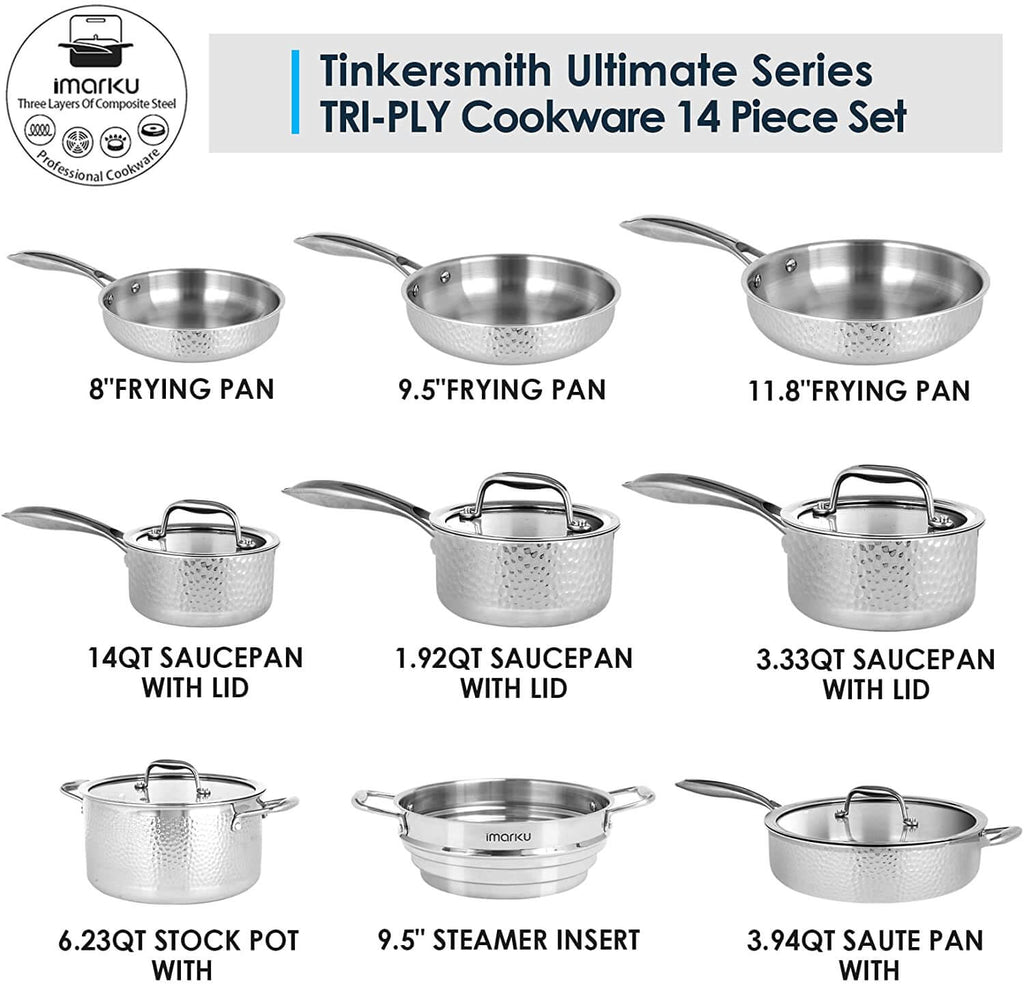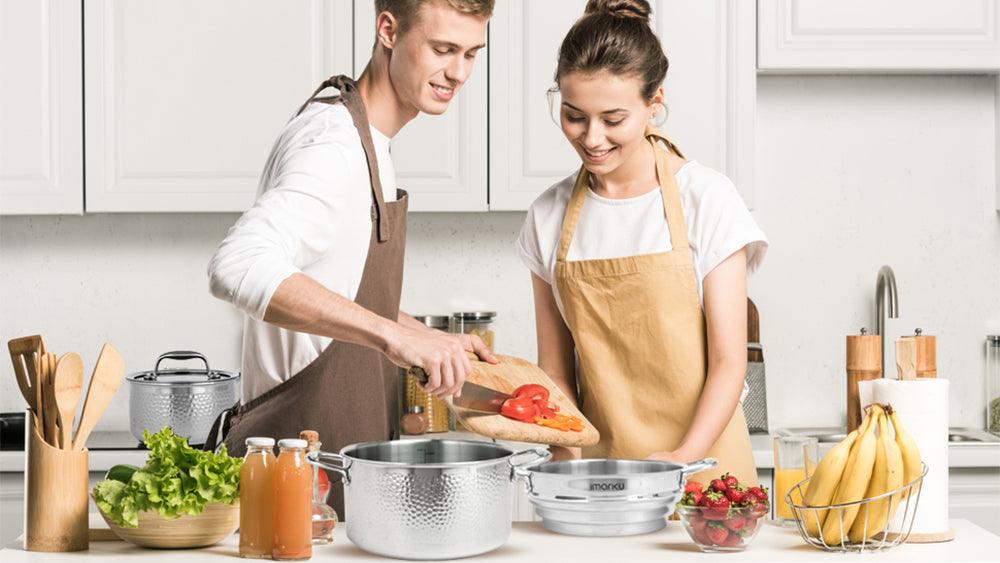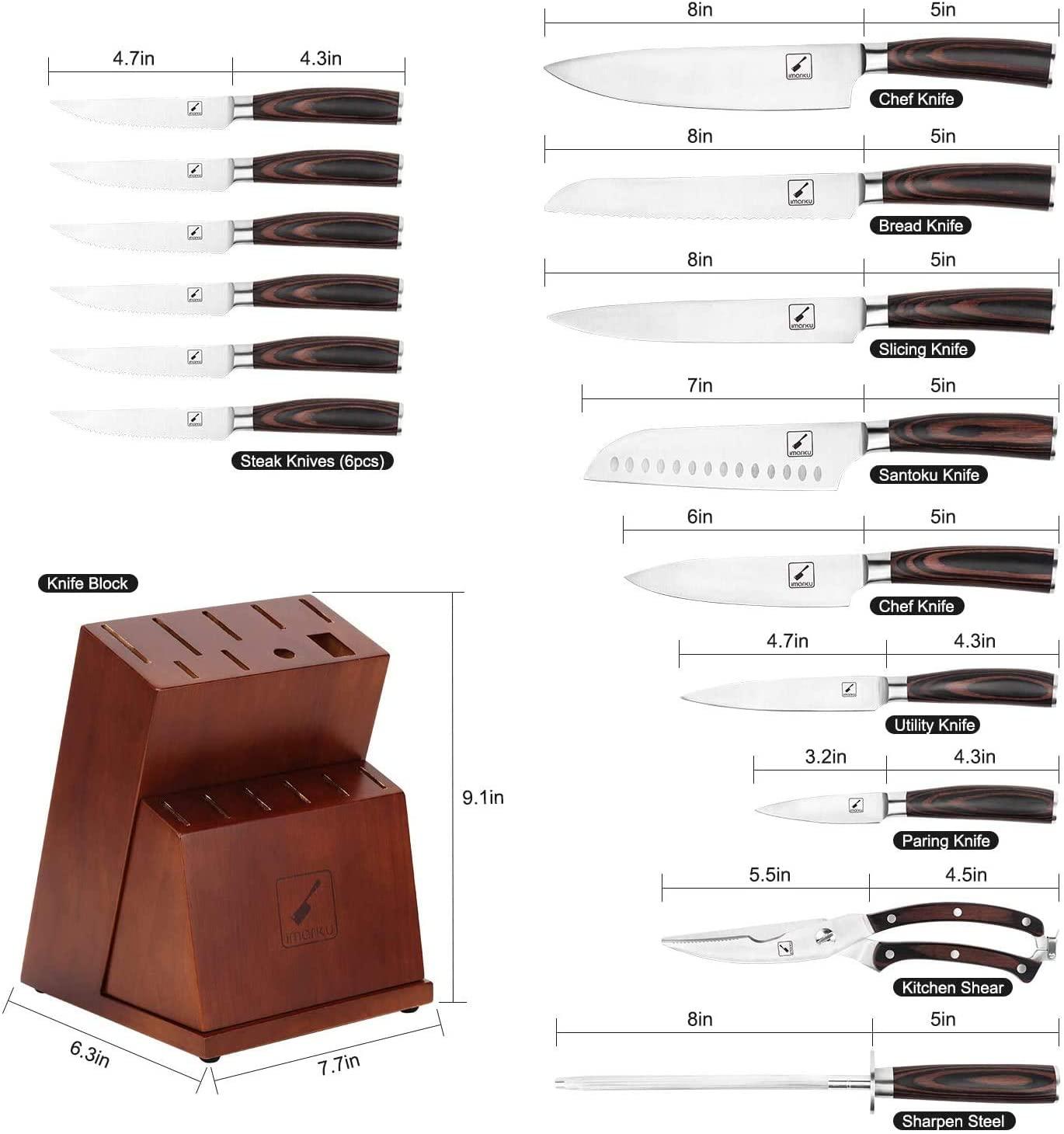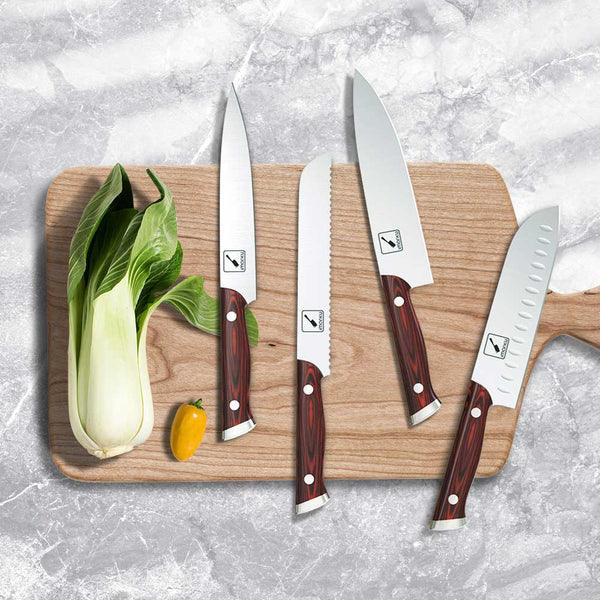TABLE OF CONTENTS
Stainless-steel cookware sets are the mainstream contemporary cooking utensils. This isn't just a passing trend since they are elegant, durable, efficient, and valuable. If you are looking for the best stainless steel cookware, then here is an overview highlighting the benefits of such pots and pans and what to look for when buying them.
What is Stainless Steel?
It's steel with less than 1.2% carbon, at least 10.5% chromium, and other alloy elements. Steel is durable and stronger than iron, even though it can still corrode and rust. To prevent this, the steel material is usually combined with chromium.
What is Food Grade Stainless Steel?
Food-grade stainless steel is resistant to wear or tear. It has an extremely high level of heat resistance, making it safe for cooking various food types. The type 200 series, 300 series, and 400 series are safe for making food equipment as per the NSF International for Food Equipment Material guidelines.

Benefits Of Using Stainless Steel Cookware
So, why are stainless-steel cookware sets found in most kitchens? From durability, ease of use, excellent performance to value for money, here are some of their benefits:
Durable
Stainless steel cookware is almost indestructible. You can scrub or bang it by. It will remain functional. Even better are stainless-steel cookware sets clad with copper or aluminium. They have better durability and can serve you for years or decades.
Excellent Cooking Performance
Multi-ply stainless steel offers the ultimate kitchen performance. That's why chefs love such sets since they quickly absorb heat and evenly distribute it. Stainless steel cookware sets are usually made with copper or aluminium layers at the base to enhance heat transfer efficiency. This is because stainless steel isn't the best heat conductor on its own.
One of the most popular cookware products that offer excellent cooking performance is the imarku 14-piece no-coating cookware sets which we will discuss below.
Retains Food Quality
This type of kitchenware doesn't impact your food's taste or its nutritional value. Well, this is a special feature since materials such as copper and cast iron can easily interfere with your food's taste.
Generally, stainless steel makes your cookware safe for use. It's practically nonpoisonous.
Non-Reactive
This material is relatively inert, so it doesn't react with most food products. Materials such as copper and cast iron easily react with acidic food. They can, therefore, release toxic chemicals into your food.
Easy Maintenance
All stainless-steel cookware needs simple care. You don't have to worry about dents, rust, or peeling. These cooking pots need everyday cleaning. Just make sure that you dry them immediately after washing, and don't forget to use the right solution and cleaning sponge.
Easy to Clean
The hard, smooth, and non-porous surfaces are easy to clean. You can use a soft sponge to do this. If there are sticky food bits, you can soak your pot before cleaning it. Alternatively, you can use the dishwasher; make sure that you don't do this often because you will end up lessening the smooth polished surface. Learn more about how to clean stainless steel pans.
Versatile
You can use such kitchen set to steam, fry, steam, poach, stew, boil, or braise food. Such pots can withstand higher heat levels with minimal issues.
Value for Money
Initially, the cost of such kitchenware can put you off. However, look at such cookware's efficiency, safety, and durability. You will realize that such pots offer value for money in the long run. If well-maintained, they can serve you for decades.
You can find the pots and pans at a wide range of prices, from budget-friendly, mid, to high-end.
Recyclable Material
If you are conscious of the environment, stainless steel is fully recyclable. You don't need to discard your old or unwanted kitchenware since the same items can be salvaged and used differently.
Great Esthetics
While you are guaranteed value for money, good performance, and durability, such pots and pans have great esthetics that makes them ideal for use in modern, urban country, or traditional kitchens. It should be noted that modern stainless-steel pots have beautiful accents, including chef-styled designs which transform the overall cooking experience.

What to Look for When Buying Stainless-steel Cookware?
To make the right purchase decision, it's important to consider specific but essential factors that high-quality stainless-steel cookware has. Some of the features to look for include:
The Grade of Stainless Steel
In terms of grade, ensure that you pick pots with 18/10 or 18/8 standard. There is little difference between these two standards since they are corrosion-resistant, stable, and durable. You can easily check the standard on the cookware's box.
Type of Finish
You can either pick brushed or polished stainless steel. The brushed stainless-steel finish has a dull, non-reflective, matte finish. Its surface contains wire brush strokes and its effectiveness in hiding wear and tear.
On the other hand, polished stainless steel has a mirror-like finish, and it sometimes appears like chrome. It's smooth, making it difficult to hide dents and scratches.
Construction and Core
Materials used in the core determine the efficiency of the cookware since stainless steel itself is a poor heat conductor. Therefore, the best stainless steel cookware is usually made with copper or aluminium core. These materials have superior heat conductivity and enhance the stainless-steel material's durability.
The core is usually "clad" with either copper or aluminium in between the layers of stainless steel. These layers are known as ply. A tri-ply steel consists of a metal core (mostly aluminium) sandwiched between stainless-steel layers.
So, what makes a tri-ply different from regular stainless steel? The latter doesn't have the inner core; hence it can't effectively conduct heat. It should be noted that cookware sets that are poor heat easily buckle and can't effectively or quickly distribute heat.
Note: there are also 5- and 7-ply cores. However, a higher ply doesn't mean better heater conduction and distribution.
Other construction components include:
• Lids: consider glass lids since they offer better views while cooking food. Besides that, glass lids always look elegant.
• Handles: most cookware made with stainless steel has riveted handles that offer better performance than spot-welded handles. But understand that stainless-steel handles aren't ideal for hot ovens since they can get hot. If you consider stainless-steel handles, pick those with long and hollow designs. They have large surface areas hence effective in dispersing heat.
• Rims: a simple flared lip on the edge of the pot enhances the ease of pouring liquids without creating a mess.
Versatility
While it's good to buy cookware sets, it's impossible to buy pots and pans for everything we need to prepare. So, versatile sets are ideal for any kitchen. They can effectively cover different cooling styles, including boiling, simmering, sauteing, steaming, etc.
Weight
When carrying your stainless-steel pot, there should be a certain sign of "heftiness". It shouldn't be extremely heavy, but it shouldn't be lightweight as well.
Generally, heavier cookware is most likely cladded, and this means that more than one material was used to craft it. While it might be costly, the chances are that you will get value for your money. Besides that, such cookware is sturdier, evenly distributed heat, and less susceptible to dings and dents.
Warranty
High-quality cookware usually comes with a warranty. A cookware is a huge kitchen asset and personal investment; hence buyers want to ensure they are guaranteed support or replacement if there's a need. So, the type of pan or pot you buy should at least have a one-year warranty.
Personal Considerations
There are certain things you'd love or hate in your kitchen set. While these factors may vary from person to person, they can be found in the same categories. They include:
The set size and pieces in the set size
This depends on the size of your family and needs. But always consider a smaller set rather than a bigger set because, with the latter, you might end up buying pots that you don't need. With a smaller set, you can always add in the missing pieces.
When it comes to size, this is still a personal preference. Most sets have 2 quarts saucepans and a 10-inch skillet. However, a 12-inch skillet is more versatile and useful in most kitchens.
Budget
This is an important consideration for everyone. Even though clad stainless-steel pots aren't cheap, they are of good quality and offer value for money. Additionally, they are available in various price levels and so you will most likely find the cookware you can afford.
Induction compatibility
Most stainless-steel cookware sets currently are induction compatible. But to make sure that it has a magnetic base.
Ease of cleaning
Most stainless-steel cookware users usually complain about stickiness. However, there are several ways to get around this issue, such as ensuring that the pan is hot before using it. Other features that enhance ease of cleaning include the lack of rivets to minimize gunk collection.
Esthetic considerations
A cookware's design is an important status symbol in modern homes, so you might want to consider the esthetic appeal of your pots. We all have different tastes, but most people are moving towards simple but elegant cookware sets with minimalist vibes that suit different kitchen designs.

How to Care for / Maintain Stainless Steel Cookware?
While stainless-steel cookware is easier to manage or care for, you still need to correctly maintain them to avoid damage, debauchery, and discoloration.
Water spots: to prevent your cookware from forming this annoying water spot, ensure that you dry your pan immediately after washing. But in case the water spots have already formed, then use a damp sponge to wipe them and then rinse as usual before drying.
• Use medium heat: the ideal cooking heat is medium, and it helps prevent food from sticking around the pain. Besides that, this heat range also helps release already stuck food bits from the stainless-steel cookware's surface.
• Don't soak a hot pan: once you are done cooking, give your pan several minutes to cool off before you soak it. This is because soaking a hot pan often leads to warping. On the other hand, don't let the pan soak for extremely long periods since this will result in pitting.
• Food storage: avoid storing food in your pans, especially acidic foods.
• Heat your pan before adding oil: always leave your pan to heat before adding oil. It would be safe to add food once the oil is hot. Adding oil when the pan is already hot usually creates a static stainless-steel surface that's temporarily non-stick.
• Only salt boiling hot water: pitting corrosion normally occurs when pre-boil water is salted, leaving the cookware with horrible pockmarks, especially in the pot's bottom.
• Don't rush the pre-heating process: doing this usually makes the pan overheat quickly, and you will end up burning your food. This is because stainless steel is highly effective in holding heat.
• Use non-abrasive cleaners: sponges are the most ideal in cleaning stainless-steel cookware. Avoid coarse scrubbers or harsh cleaning solutions since they will damage your cookware by resulting in unwanted scratches.
• Stick to a cleaning routine: the best way to care for your stainless-steel pots and pans after every use. Even if your pot is not very dirty, ensure that you clean it to avoid a buildup.
To tackle specific problem areas such as:
- Discoloration – it often results in a rainbow appearance in stainless-steel cookware. Discoloration occurs from overheating, but you can remove it by splashing a vinegar solution into your pan then swirling the vinegar solution around before using a non-abrasive sponge to clean the stains.
- General Buildup – fill your pan with hot soapy water and leave it for a few hours. Use a non-abrasive sponge to scrub the buildup.
- Chalky white spots mostly result from calcium buildup, especially from calcium-rich water. Pour homemade water and vinegar solution (3:1) into the cookware and let it boil, then leave it to cool. Wash and dry your cookware as normal.
- Stuck-on food bits normally result from adding cold food to already hot cookware. To tackle this, scrub the stainless-steel cookware with a non-abrasive sponge to get as many food bits off as possible. Go ahead and fill the cookware with soapy water and bring it to a boil. Gently scrape off the food bits, which by now should come off easily. If they are still difficult to scrape off, replace the soapy water with baking powder and repeat the procedure.
How Do I Make a Stainless Steel Pan Non-stick?
Heat the pan over medium or medium-high heat for around 2 minutes. After that, add enough coat of vegetable oil that fully covers the entire bottom of the pan and then heat the oil until smoking wisps begin to appear. You would have temporarily turned your stainless-steel pan into a non-stick pan.
Can You Make Eggs in a Stainless-steel Skillet?
Stainless steel skillets are versatile, and so you can use them to prepare a wide range of foods, including eggs. But how can you make your eggs in such cookware without sticking? Well, here's how you can do it.
Bring your stainless-steel cookware to low-medium heat to create a tender environment. It should be noted that when the heat is too high, the eggs will become rubbery. To become a master in using a stainless-steel skillet to prepare your eggs, you must regulate the temperature. If you have the appropriate amount of fat and the skillet's temperature is too high or too low when the eggs are added, then there's no reason your eggs should stick.

Stainless-steel Cookware Set Recommendation
Imarku is one of the top brands renowned globally for making high-quality professional kitchen knives. If you are looking for the best stainless steel cookware, you should consider Imarku 14-piece no coating cookware sets that are oven-safe and can withstand up to 500 degrees Fahrenheit of heat.
About Imarku 14-Piece No Coating Cookware Sets
These sets consist of pans and pots:
- A 6.23 qt stock cooking pot + lid
- 8, 9.5. and 11.8-inch frying pans
- A 9.5-inch insert + helper handle
- 3.94 qt sauté pan + lid
- 1.14, 1.92, and 3.33, qt saucepans + 3 lids
Each product is made with a unique hammered surface, so you don't have to worry about the cookware's coating coming off or mixing with your food. The sets are ideal for big families and contain everything your kitchen needs.
Design Features
These are premium cookware sets designed to offer efficiency and cater to different family needs. The sets design features include:
-
Triple-Ply Construction
The no-coating cookware sets are dishwasher safe and heat quickly. The triple-ply construction stainless-steel material ensures food is heated evenly and quickly. This premium feature is heat-resistant, corrosion-resistant, and dishwasher safe, ensuring that the pan and pot sets are easier to clean.
The tri-ply construction clad consists of:
1. Food grade stainless steel
2. Aluminum core
3. Induction-ready magnetic stainless steel
-
Sturdy and Ease of Use
This cookware has been designed to offer home chefs efficiency in food preparation. They have measurement markings to ensure that you prepare the food amount.
Each set is covered with a sturdy 2.5 mm-thick high-quality stainless steel. This helps to minimize the chances of deformity during cooking. Besides that, you can comfortably cook at low-medium heat on the stovetop with the help of handles remaining cool.
-
Warranty
You are guaranteed a hassle-free one-year warranty with ongoing support or a replacement for your stainless-steel pan.

Stainless-steel FAQs
Q: Are there specific utensils I need to use with stainless-steel cookware?
A: No. stainless-steel cookware is flexible to use, and you can use it alongside any kitchen utensil, including those made up of wood and plastic materials.
Q: Is stainless steel a safe material?
A: It depends on how you look at it. Generally, stainless steel is recognized as a safe material for making cookware. The recommended stainless-steel material is rated 304 or 316. These are high-quality materials that won't lose their non-stick profiles over time, like coated aluminium pans or less durable and poor heat conductors such as ceramic and glass pans.
However, there is another angle of view that makes stainless-steel materials unsafe. Stainless steel can leach chromium and nickel into food, even though in low quantities since it's relatively inert.
Small quantities of nickel are not poisonous. However, some people are allergic to nickel, resulting in a reaction such as skin irritation.
On the other hand, small doses of chromium are good for your health. However, consuming high amounts of chromium can lead to serious side effects.
Q: Is stainless steel reactive?
A: Yes, but you can minimize its reactivity in the following ways:
Refrain from using abrasive cleaners to scour your stainless-steel pans and pots.
Avoid using your pans to prepare salty or high acidic food that will lead to corrosion.
Remove food from your cooking pot as soon as possible and avoid using your cookware to store food.
Q: Will my stainless-steel cookware rust?
A: high-quality stainless steel is resistant to stains, corrosion, and rust. But resistivity doesn't eliminate the possibility of rusting. So, stainless-steel cookware can rust, and this could be due to:
• The quality of the steel: the main element in stainless steel that makes it rust-resistant is chromium. Generally, a stainless-steel material must have at least 10.5% chromium by weight. But this might vary from country to country since stainless-steel cookware should have at least 16% chromium in the US.
• Steel composition: the ideal steel composition for cookware is 304/316 stainless steel.
• How the cookware is used: harsh scouring, harsh detergents, and preparing too much acidic or salty food can easily make your stainless-steel to rust.
Conclusion
Stainless steel cookware sets are popular due to their efficiency, versatility, and elegant features. They are also the safest cookware options for any home, and home chefs love them for their effectiveness and efficiency. They are available in different sizes and set profiles. So, to pick a set that suits your needs, consider your personal preferences, price, weight, construction, and core. Overall, you can't go wrong with such cookware in your kitchen since the designs are classics.






















Leave a comment
All comments are moderated before being published.
This site is protected by hCaptcha and the hCaptcha Privacy Policy and Terms of Service apply.